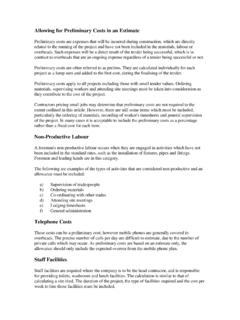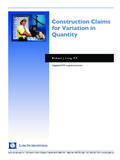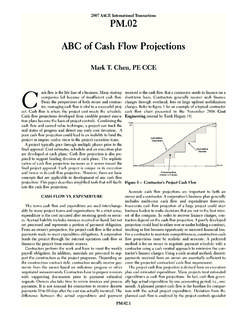Transcription of 20120125 The Analysis and Valuation of Disruption
1 The Analysis and Valuation of Disruption by Derek Nelson, Senior Vice President & Regional Managing Director Asia Hill International, Inc 25 January 2011 The Analysis and Valuation of Disruption Page | 2 Table of Contents Introduction 3 What is Disruption ? 3 What is Productivity? 4 Why is Productivity Important? 4 Background 5 Factors Affecting Labour Productivity 5 Project Change 7 Extent of Project Change 8 Disruptions and Cumulative Impacts 9 Methods of Quantifying Lost Productivity 10 Project Practice Based Methods 13 Measured Mile Analysis 13 Baseline Productivity Analysis 16 System Dynamics Modelling 17 Earned Value Analysis 22 Sampling Methods 23 Comparison Studies 24 Industry Based Methods 24 cost Based Methods 24 Other Quantifying Methods 25 Matching the Quantifying Methods with Project Practice 26 Conclusions 27 Attachment 31
2 The Analysis and Valuation of Disruption Page | 3 Introduction Complaints of Disruption and additional costs are routinely made during the course of a construction project yet they remain notoriously difficult to prove. One of the main reasons for this is that productivity losses are often difficult to identify and distinguish at the time they arise, as opposed to other money claims which are more directly concerned with the occurrence of a distinct and compensable event together with a distinct and direct consequence, such as an instruction for a discreet variation during the progress of the works or a properly notified compensation event.
3 As such, most claims for Disruption are dealt with retrospectively and the claimant is forced to rely on contemporary records to try and establish a causal nexus for identified losses (cause and effect) which are all too often inadequate for the purposes of sufficiently evidencing a loss of productivity claim. When this happens the claimant is often forced into the situation where it advances a weak global or total cost claim of sorts to try and recover some of its losses. The cause and effect burden of proof is the same for a claim for loss of productivity as for any other claim insofar as the claiming party must first establish that the event or factor causing the Disruption is a compensable risk event under the contract.
4 To do this, the contract needs to be reviewed to understand the basis of the agreement as certain productivity issues may have been foreseeable and therefore accounted for within the claimant s productivity allowances. The contract may also identify if a party expressly accepted certain productivity risks. Where courts and tribunals have a clear focus on linking cause and effect, claims for Disruption will come under greater scrutiny. It is unlikely that contractors and subcontractors will succeed where their claims for Disruption are based simply on a global overspend on labour or plant for the whole of the contract working period.
5 Sufficient detail is required to isolate the cause of the Disruption complained of and evaluate the effects of that Disruption . What is Disruption ? Disruption is loss of productivity, disturbance, hindrance or interruption to a Contractor s normal working methods, resulting in lower efficiency. In the construction context, disrupted work is work that is carried out less efficiently than it would have been, had it not been for the cause of the Disruption . If caused by the Employer, it may give rise to a right to compensation either under the contract or as a breach of Construction contracts have two major types of costs associated with them: fixed and variable.
6 Fixed costs are those costs that the contractor procures on a fixed price subcontract or purchase order. Fixed costs are inherently lower in risk, because the contractor has fixed them through a contract. Risks do exist, such as the financial failure or default of either a vendor or subcontractor or the installation of defective or faulty work by a subcontractor or vendor, but the risks are much less than the risks in variable cost items. 1 SCL Delay and Disruption Protocol: October 2002.
7 The Analysis and Valuation of Disruption Page | 4 Variable costs are items such as the contractor's labour, equipment, and site overhead. Extensive literature has been published about delay claims, which principally are claims related to the extended duration of the job and the resulting extended site overhead costs. However, the major variable risk component on a construction project is labour, not extended site overhead. Equipment, on certain types of construction such as utility, heavy, and highway construction, can be a significant cost ; however, equipment costs tend to be proportional to labour costs.
8 It is uncommon to have significant increases in equipment costs without significant increases in labour costs. On many construction projects, the largest single area of cost overrun is in labour costs. This is not surprising given that labour is frequently the largest variable cost for a contractor. Claims involving lost productivity are frequently referred to as Disruption claims. What is Productivity? Productivity = Production Output/Resource Input = 4 m of 4 pipe/labour hour Productivity Ratio = Actual Productivity/Planned Productivity = 3 m per hr/4 m per hr = Why is Productivity Important?
9 Hypothetical Project cost Components Labour 40% Often the largest cost component; Most volatile cost component Most critical cost to control Materials 40% General Conditions and Indirect Costs 10% Overhead 5% Profit 5% Total 100% Should the above project suffer a overrun on the labour cost component: Hypothetical Project cost Components Labour 40% 45% Arising from a overrun on labour content Materials 40% General Conditions and Indirect Costs 10% Overhead 5% Profit 5% 0% A overrun on labour content Wipes out all profit on the project Total 100% The Analysis and Valuation of Disruption Page | 5 The existence of a labour cost overrun is not proof that an event entitling a contractor to damages has occurred.
10 Clearly labour cost overruns can occur for a variety of reasons, not all of which entitle a contractor to compensation. One of the most contentious areas in construction claims is the calculation or estimation of lost productivity. Unlike direct costs, lost productivity is often not tracked or cannot be discerned separately and contemporaneously. As a result, both causation and entitlement concerning the recovery of lost productivity can be difficult to satisfactorily establish. Compounding this situation, there are numerous ways to calculate lost productivity and no uniform agreement within the construction industry as to a preferred methodology of calculating lost productivity.








